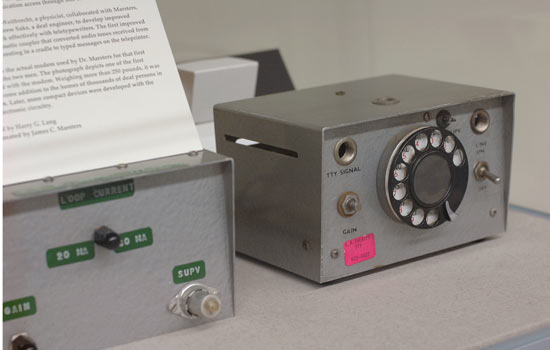First TTY modem on display in Wallace Library
A. Sue Weisler
This TTY machine—one of the first—will permanently be on display at NTID.
A piece of communications history that allowed people who are deaf to make their own phone calls for the first time is on permanent display at RIT’s Wallace Library. One of the two modems used for the first call on a TTY—or teletypewriter—more than 40 years ago is featured on the first floor of the library as part of its Deaf Archives collection.
The modem was donated by Harry Lang, professor in NTID’s master of science in secondary education teacher preparation program, and author of A Phone of Our Own: The Deaf Insurrection Against Ma Bell, published in 2000.
“This was one of the most significant breakthroughs in the history of telecommunications for deaf people,” Lang says. “It marked the beginning of a new era in self advocacy. Deaf people developed and marketed their own device. The modem on display represents the beginning of a major revolution.”
In May 1964, Robert Weitbrecht, in Redwood City, Calif., and James Marsters, in Pasadena, Calif., made history with the first long distance TTY phone call on a traditional telephone line. That call was a significant achievement and meant more independence for deaf people, who had waited 90 years for access to the common household telephone.
Eventually, relay centers opened to connect TTY users with non-TTY users, allowing deaf parents to call schools when their children were sick, deaf and hearing friends and family members to chat at ease and deaf college students to have pizzas delivered without depending on hearing friends.
Weitbrecht, a physicist, is credited with inventing the TTY modem with help from Marsters, an orthodontist, and Andrew Saks, a deaf engineer. For several decades, the three men collaborated to develop improved modems that would work effectively with teletypewriters. The first improved designs included an acoustic coupler that converted audio tones received from the telephone handset resting in a cradle to typed messages on the teleprinter.
“Before I acquired my first TTY, I was completely dependent on hearing people to make phone calls,” says Lang, who is deaf. “Before the TTY, I would have to drive to friends’ homes and talk to them in person, if they were home. When I wanted to ask a girl out for a date, I would have to ask friends to help. It was a frustrating time.”
NTID was asked to participate in the event by the American Educational Research Association, a coalition member.









